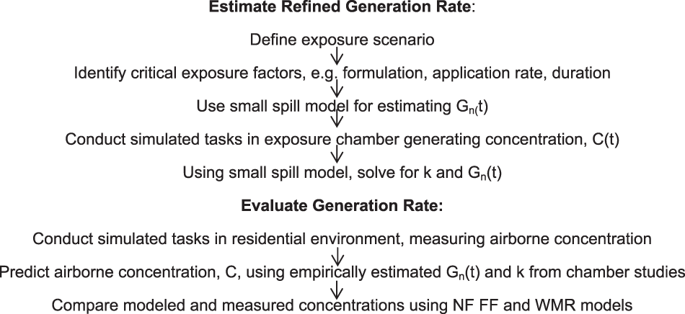Journal of Exposure Science and Environmental Epidemiology ( IF 4.1 ) Pub Date : 2019-05-14 , DOI: 10.1038/s41370-019-0142-5 Susan Arnold 1 , Gurumurthy Ramachandran 2 , Hannah Kaup 1 , Joseph Servadio 1

|
Understanding the relationship between consumer product use and risk of adverse health outcomes facilitates appropriate risk management and product stewardship. A preferred method for estimating the systemic and respiratory tract exposure and dose tailored to cleaning products use has been proposed, refining previously issued exposure guidance. Consistent with other exposure and risk-assessment frameworks, it is dependent upon high-quality exposure determinant data that also serve as model inputs. However, as publicly available exposure determinant data are scarce, the risk assessor is left with the option of estimating determinants such as the generation rate or employing empirical methods to estimate them. When the exposure scenario involves a chemical mixture, estimating the generation rate may not be feasible. We present an approach for estimating the time-varying generation rate of an aqueous acetic acid mixture representative of the base formulation for many consumer and DIY cleaning products that was previously assessed in a screening-level assessment. The approach involved measuring the evaporation rate for a reasonable worst-case scenario under controlled conditions. Knowing the mass applied, a time-varying generation rate was estimated. To evaluate its portability, a field study was conducted in a home where measurements were collected in an all-purpose room with the exterior door open (Room 1) and closed (Room 2), and a bathroom (Room 3) using a portable Fourier Transform Infrared (FTIR) spectrophotometer. Acetic acid concentrations were modeled using two common indoor air models, the Well Mixed Room model. Measured and modeled acetic acid concentrations were compared, with the WMR 95% confidence intervals encompassing measured concentrations for all three rooms, supporting the utility of the approach used and portability of the generation rate derived from it.
中文翻译:

估计通用地板清洁剂随时间变化的乙酸生成率。
了解消费品使用与不良健康后果风险之间的关系有助于进行适当的风险管理和产品管理。已经提出了一种用于估计全身和呼吸道暴露以及针对清洁产品使用量身定制的剂量的首选方法,完善了先前发布的暴露指南。与其他暴露和风险评估框架一致,它依赖于高质量的暴露决定因素数据,这些数据也可作为模型输入。然而,由于公开可用的暴露决定因素数据稀少,风险评估者只能选择估计决定因素,例如生成率或采用经验方法来估计它们。当暴露场景涉及化学混合物时,估计生成率可能不可行。我们提出了一种方法,用于估算代表许多消费品和 DIY 清洁产品基础配方的醋酸水溶液随时间变化的生成率,该产品之前已在筛选水平评估中进行过评估。该方法涉及在受控条件下针对合理的最坏情况测量蒸发率。知道施加的质量,估计随时间变化的生成率。为评估其便携性,在家中进行了一项实地研究,在一个多功能房间(外门打开(房间 1)和关闭(房间 2))和浴室(房间 3)中使用便携式傅里叶测量仪收集测量值变换红外 (FTIR) 分光光度计。使用两种常见的室内空气模型(混合室模型)对乙酸浓度进行建模。











































 京公网安备 11010802027423号
京公网安备 11010802027423号